Bank of Nova Scotia Bundle
Unveiling the Inner Workings of Bank of Nova Scotia?
Bank of Nova Scotia, or Scotiabank, is a financial powerhouse with a significant global footprint. As one of Canada's leading Bank of Nova Scotia SWOT Analysis, it offers a diverse range of financial services. Understanding its operations is crucial for anyone looking to navigate the complexities of the financial world.
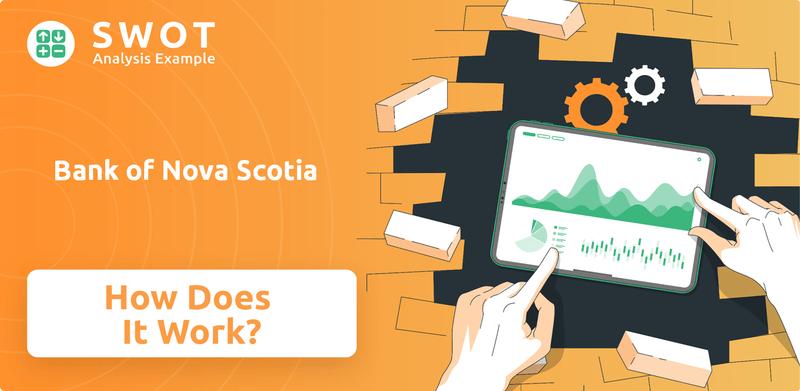
This analysis will delve into Scotiabank's core business model, exploring how this Canadian bank generates revenue and maintains its competitive edge. From banking operations to its international presence, we'll dissect the key elements that drive its performance. Whether you're interested in financial services or seeking insights into BNS, this exploration offers a comprehensive overview.
What Are the Key Operations Driving Bank of Nova Scotia’s Success?
The core operations of Bank of Nova Scotia (Scotiabank) revolve around delivering a wide array of financial products and services. These offerings cater to various customer segments, including individuals, small businesses, corporations, and institutional clients. The bank's structure is primarily divided into Canadian Banking, International Banking, Global Wealth Management, and Global Banking and Markets.
Scotiabank's value proposition centers on providing accessible, tailored financial solutions and expert advice. This approach aims to foster financial well-being and support economic growth within the communities it serves. The bank leverages its extensive branch network and digital platforms to reach a broad customer base.
The bank's operational processes are supported by a robust technology infrastructure, a large branch network, and an increasing emphasis on digital channels. Scotiabank has been actively investing in digital transformation to improve customer experience, streamline operations, and boost efficiency. For example, digital sales in Canadian Banking reached 48% in Q1 2024, up from 43% the previous year. The bank's supply chain includes strategic partnerships to enhance service delivery.
Focuses on retail and commercial banking services within Canada. Offers everyday banking, mortgages, loans, and credit cards. This segment serves both retail and commercial clients across the country.
A key differentiator for Scotiabank, it operates primarily in Latin America, the Caribbean, and Central America. Leverages a strong branch network and digital platforms to serve emerging markets. International Banking reported net income of $700 million for Q1 2024, a 2% year-over-year increase.
Provides investment management, private banking, and brokerage services. Helps clients grow and preserve their wealth. This segment caters to high-net-worth individuals and institutional clients.
Offers corporate and investment banking solutions, including capital markets, corporate lending, and advisory services. Serves large corporations, governments, and institutional investors worldwide. This segment supports major financial transactions and advisory needs.
Scotiabank's international footprint, particularly in high-growth Latin American markets, is a significant differentiator. This diversification provides resilience against regional economic downturns and offers substantial growth opportunities. Scotiabank's focus on digital transformation and customer experience enhances its competitive position.
- Strong presence in Latin America and the Caribbean.
- Emphasis on digital transformation and customer experience.
- Comprehensive financial services for diverse customer segments.
- Strategic partnerships to enhance service delivery.
The bank's ability to adapt and innovate is crucial in the ever-changing financial landscape. For more details on Scotiabank's strategic direction, consider reading about the Growth Strategy of Bank of Nova Scotia.
Bank of Nova Scotia SWOT Analysis
- Complete SWOT Breakdown
- Fully Customizable
- Editable in Excel & Word
- Professional Formatting
- Investor-Ready Format
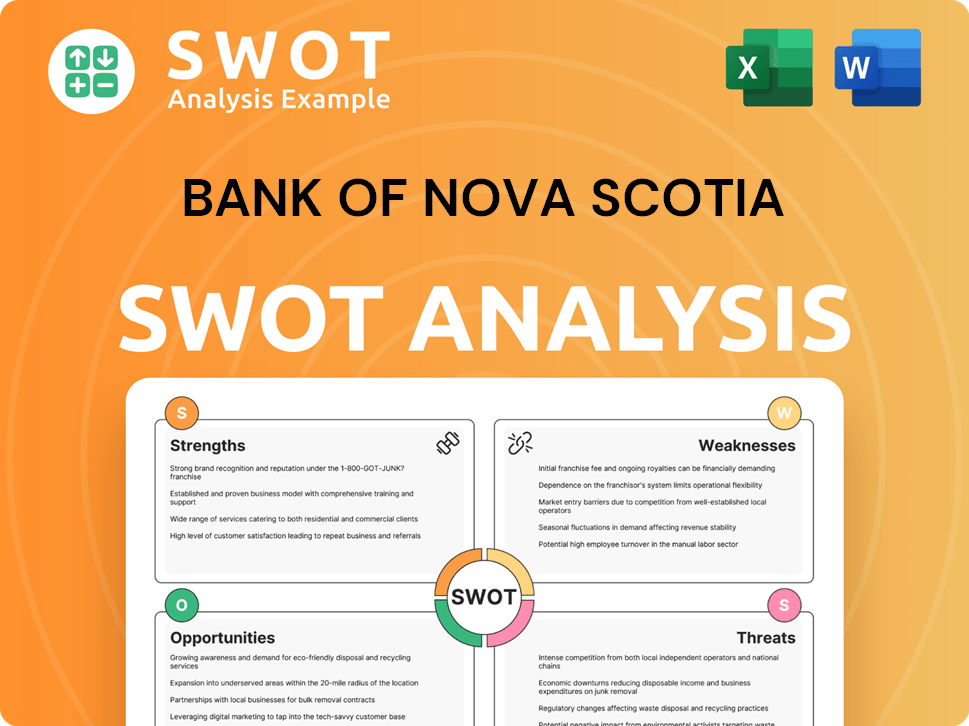
How Does Bank of Nova Scotia Make Money?
Scotiabank, a prominent Canadian bank, generates revenue through a diverse range of financial services. Its revenue streams are primarily categorized into net interest income and non-interest income. Understanding these streams provides insight into how Scotiabank operates and maintains its financial health.
The bank's financial performance is a key indicator of its success, with total revenue figures reflecting its overall profitability. Scotiabank's strategic approach to revenue generation involves various monetization strategies across its different business segments. This includes traditional banking operations and wealth management services.
For the first quarter of fiscal year 2024, Scotiabank reported total revenue of $8,429 million. This showcases the significant scale of its operations and the effectiveness of its revenue-generating activities.
Net interest income is the difference between the interest earned on assets (like loans) and the interest paid on liabilities (like deposits). This is a significant revenue source for Scotiabank, forming a major part of its overall income. Fluctuations in interest rates can directly impact this income stream.
Non-interest income comes from various sources, including fees, commissions, and trading revenues. This diversification helps to stabilize Scotiabank's revenue, reducing its reliance on interest rate-sensitive income. This includes fees from banking services, wealth management advisory fees, and credit card fees.
Fees for banking services, wealth management, and credit cards contribute significantly to non-interest income. These fees are charged for various transactions and services, providing a steady revenue stream. The bank also earns commissions from mutual fund sales and brokerage activities.
Global Banking and Markets generates revenue through trading activities, including foreign exchange and other market transactions. These revenues can be volatile but contribute significantly to the bank's overall financial performance. This segment also earns fees from underwriting and advisory services.
Scotiabank's wealth management segment earns revenue from advisory fees, mutual fund commissions, and brokerage activities. For Q1 2024, Global Wealth Management reported net income of $381 million, a 12% year-over-year increase. This growth was driven by higher mutual fund fees and brokerage revenues.
The expansion of digital offerings contributes to revenue through increased customer engagement and efficiency gains. Digital banking features allow for streamlined transactions and reduced operational costs. This strategy helps Scotiabank stay competitive and meet evolving customer needs.
Scotiabank employs several monetization strategies to maximize revenue across its various business lines. These strategies include tiered pricing for banking products, bundled services, and transaction-based fees.
- Tiered Pricing: Offering different pricing levels for banking products based on the services used.
- Bundled Services: Providing combined services for wealth management clients to increase value and revenue.
- Transaction-Based Fees: Charging fees for corporate and investment banking activities.
- Digital Expansion: Investing in digital platforms to improve customer engagement and operational efficiency.
For more details on the ownership structure and financial performance, you can read about the Owners & Shareholders of Bank of Nova Scotia.
Bank of Nova Scotia PESTLE Analysis
- Covers All 6 PESTLE Categories
- No Research Needed – Save Hours of Work
- Built by Experts, Trusted by Consultants
- Instant Download, Ready to Use
- 100% Editable, Fully Customizable
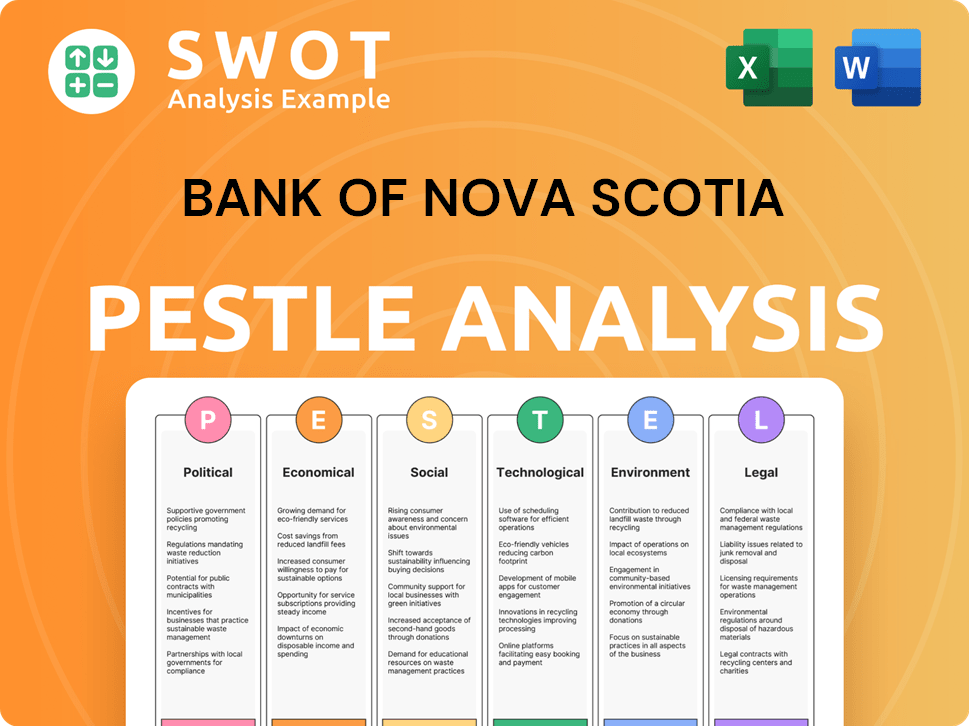
Which Strategic Decisions Have Shaped Bank of Nova Scotia’s Business Model?
Scotiabank, also known as Bank of Nova Scotia (BNS), has a rich history marked by significant milestones and strategic decisions. A key focus has been its expansion in the Americas, especially in Latin America, setting it apart from other Canadian banks. This strategy has involved both organic growth and acquisitions, enabling the bank to capitalize on high-growth markets.
The bank's operations in countries like Mexico, Peru, Chile, and Colombia form a substantial part of its International Banking segment. Moreover, Scotiabank has heavily invested in digital transformation, aiming to enhance customer experience, boost operational efficiency, and drive innovation. This includes developing new digital platforms and increasing digital sales capabilities, as seen in the rise of digital sales within Canadian Banking.
Operational challenges include navigating complex regulatory environments in various international markets and adapting to evolving customer preferences for digital banking services. Scotiabank has responded by strengthening its compliance frameworks and accelerating its digital initiatives. The Marketing Strategy of Bank of Nova Scotia has played a crucial role in these developments.
Scotiabank's journey includes significant acquisitions and expansions, particularly in Latin America, which have been pivotal in its growth strategy. These moves have allowed the bank to establish a strong presence in high-growth markets, diversifying its revenue streams and enhancing its international footprint. The bank has consistently adapted to changing market dynamics and customer needs.
The bank has focused on digital transformation to improve customer experience and operational efficiency. This includes investments in digital platforms and increased digital sales. Scotiabank has also emphasized sustainable finance and ESG considerations, integrating these into its operations to meet evolving market demands and maintain a competitive edge.
Scotiabank's strong brand recognition, built over nearly two centuries, is a key advantage. Its extensive international network, especially in the Americas, provides diversification and unique growth opportunities. The bank's commitment to technology and innovation enhances service delivery and operational efficiency, while economies of scale across diverse operations offer a cost advantage.
In fiscal year 2024, Scotiabank reported a net income of approximately CAD$7.4 billion. The International Banking segment contributed significantly to this, with strong performance in Latin American markets. Digital sales continue to rise, with over 50% of retail sales conducted digitally. The bank's focus on operational efficiency and cost management has helped maintain profitability.
Scotiabank's success is built on its strong brand, international presence, and commitment to innovation. The bank's strategic focus on digital transformation and sustainable finance positions it well for future growth. These elements are crucial for maintaining a competitive edge in the financial services sector.
- Strong brand recognition and customer trust.
- Extensive international network, especially in the Americas.
- Commitment to technology and innovation.
- Focus on sustainable finance and ESG integration.
Bank of Nova Scotia Business Model Canvas
- Complete 9-Block Business Model Canvas
- Effortlessly Communicate Your Business Strategy
- Investor-Ready BMC Format
- 100% Editable and Customizable
- Clear and Structured Layout
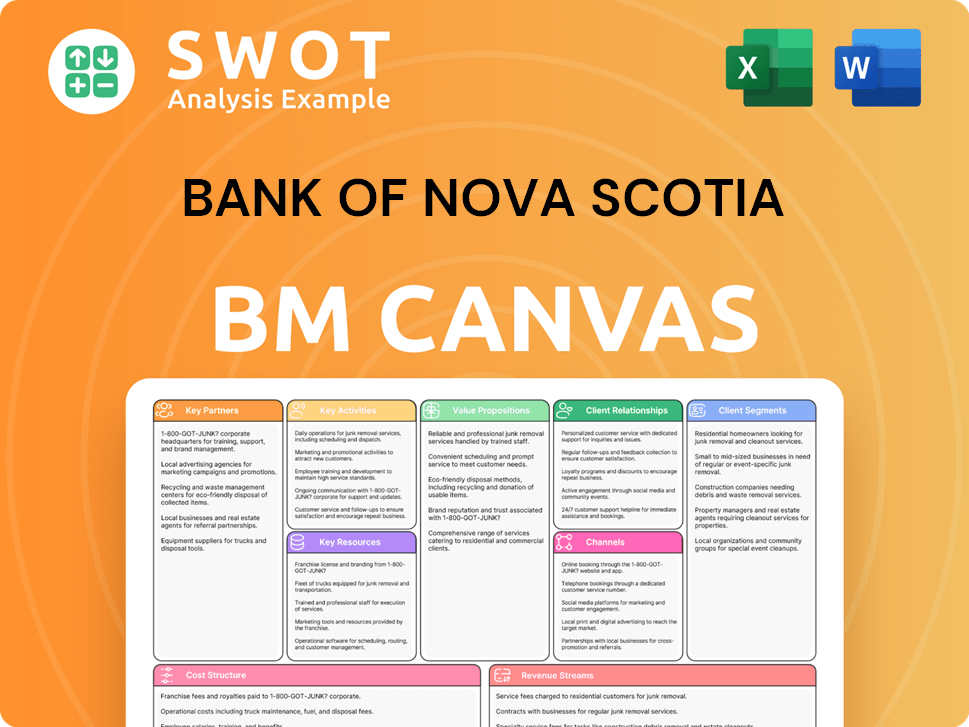
How Is Bank of Nova Scotia Positioning Itself for Continued Success?
The Bank of Nova Scotia (BNS), commonly known as Scotiabank, holds a significant position within the global financial services industry. As a leading Canadian bank, it boasts a substantial presence both domestically and internationally, particularly in Latin America. Scotiabank's diversified operations and strategic focus on key markets contribute to its unique market position and growth potential.
However, Scotiabank faces various challenges and opportunities in the evolving financial landscape. These include navigating regulatory changes, managing geopolitical risks, adapting to technological advancements, and responding to changing consumer preferences. The bank's strategic initiatives and commitment to innovation will be crucial for its continued success.
Scotiabank is one of the largest Canadian banks, with a significant market share in Canada. It has a strong international presence, especially in Latin America, which differentiates it from many competitors. The bank's extensive branch network and digital offerings support customer loyalty and provide diverse product access.
Scotiabank faces risks from regulatory changes across its operating jurisdictions, potentially increasing compliance costs. Geopolitical and economic instability in international markets can impact revenue and asset quality. Competition from FinTech companies and shifts towards digital banking also present challenges, requiring ongoing technological investment.
Scotiabank is focusing on optimizing international operations, accelerating digital transformation, and enhancing wealth management. The bank aims to leverage data analytics and AI to improve customer experiences and operational efficiency. Sustainable growth, prudent risk management, and shareholder value are key priorities.
Scotiabank's strategic initiatives include expanding its international banking operations, accelerating digital transformation, and enhancing wealth management capabilities. The bank is leveraging data analytics and artificial intelligence to improve customer experiences and operational efficiency, which are crucial for future growth.
In fiscal year 2024, Scotiabank reported strong financial results, reflecting its diversified business model and strategic initiatives. The bank's net income for the year was approximately $7.9 billion, demonstrating solid financial performance. Return on Equity (ROE) was around 12.5%, indicating efficient use of shareholder equity. The bank's Common Equity Tier 1 (CET1) capital ratio remained strong at 12.1%, reflecting a solid capital position.
- Scotiabank's revenue for 2024 was approximately $33.7 billion, driven by growth in its core businesses.
- The bank's international banking segment contributed significantly to overall revenue and profit, highlighting the importance of its global presence.
- Digital banking adoption continued to rise, with an increasing number of customers using online and mobile platforms.
- Scotiabank's focus on cost management and operational efficiency helped maintain profitability in a challenging economic environment.
Bank of Nova Scotia Porter's Five Forces Analysis
- Covers All 5 Competitive Forces in Detail
- Structured for Consultants, Students, and Founders
- 100% Editable in Microsoft Word & Excel
- Instant Digital Download – Use Immediately
- Compatible with Mac & PC – Fully Unlocked
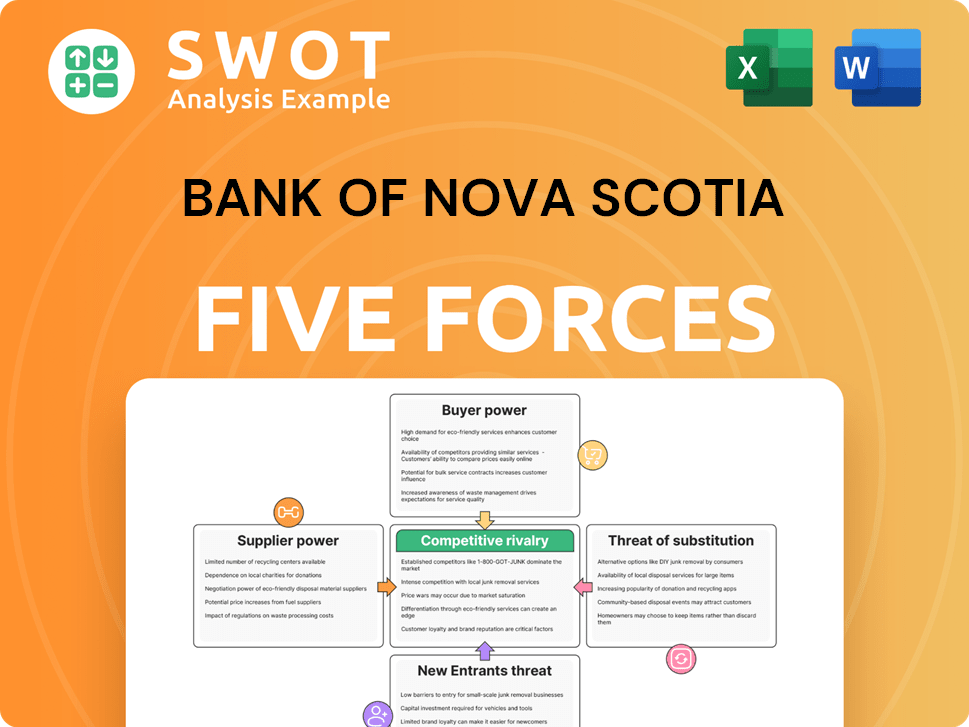
Related Blogs
- What are Mission Vision & Core Values of Bank of Nova Scotia Company?
- What is Competitive Landscape of Bank of Nova Scotia Company?
- What is Growth Strategy and Future Prospects of Bank of Nova Scotia Company?
- What is Sales and Marketing Strategy of Bank of Nova Scotia Company?
- What is Brief History of Bank of Nova Scotia Company?
- Who Owns Bank of Nova Scotia Company?
- What is Customer Demographics and Target Market of Bank of Nova Scotia Company?
Disclaimer
All information, articles, and product details provided on this website are for general informational and educational purposes only. We do not claim any ownership over, nor do we intend to infringe upon, any trademarks, copyrights, logos, brand names, or other intellectual property mentioned or depicted on this site. Such intellectual property remains the property of its respective owners, and any references here are made solely for identification or informational purposes, without implying any affiliation, endorsement, or partnership.
We make no representations or warranties, express or implied, regarding the accuracy, completeness, or suitability of any content or products presented. Nothing on this website should be construed as legal, tax, investment, financial, medical, or other professional advice. In addition, no part of this site—including articles or product references—constitutes a solicitation, recommendation, endorsement, advertisement, or offer to buy or sell any securities, franchises, or other financial instruments, particularly in jurisdictions where such activity would be unlawful.
All content is of a general nature and may not address the specific circumstances of any individual or entity. It is not a substitute for professional advice or services. Any actions you take based on the information provided here are strictly at your own risk. You accept full responsibility for any decisions or outcomes arising from your use of this website and agree to release us from any liability in connection with your use of, or reliance upon, the content or products found herein.